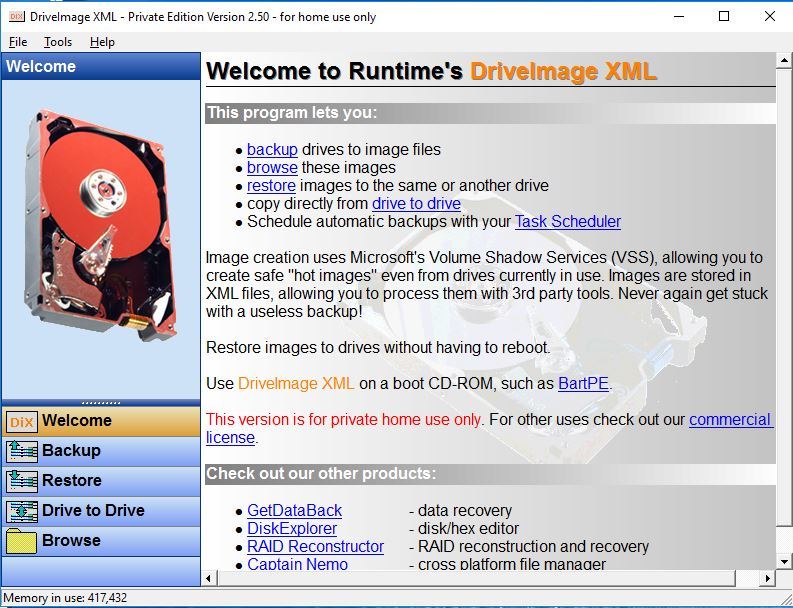
SOFTWARE CREATE DISK IMAGE WINDOWS 10 WINDOWS
Stretch the windows and panes so they are easier to read Begin Adding Answers To Your Answer File Hard Drive Partitioning Microsoft_Windows_Deploymentġ. Open Windows System Image Manager as an administratorĦ.Ĝhoose Yes on the dialog that appearsĩ. Use install.wim To Generate Some Categories To Answerġ. Copy it to your Desktop since it cannot be read directly from the CD or. It finds this information from install.wim, which is located at the root of the installation disc. Copy install.wim To Your Desktopīefore you can make an answer file, Windows needs to know what sort of answers can be applied. There are many to choose from, but this article will walk though some basic ones that many organizations might use. You will need to create an answer file, which contains the settings you want to be applied at the time you deploy the image to a computer.
SOFTWARE CREATE DISK IMAGE WINDOWS 10 INSTALL
You will need some form of a Windows 10 install media. Acquire A Windows 10 Installation Disc Or. You mainly need the Deployment Tools, but the other stuff that is pre-selected will be useful for some other projects, so keep them selected. You can just accept all the defaults the installer offers. Install The Windows Automated Deployment Kitĭownload and install the Windows 10 ADK. Deploy the image to a computer using dism.Boot the computer to WinPE after it shuts down.Create a WinPE disc or bootable USB drive.Run sysprep.exe using the Unattended.xml file.Copy the Unattended.xml file to the spare computer.Acquire a Windows 10 installation disc or.Install the Windows Automated Deployment Kit (ADK).This will also lay out the structure of this article. wim image file, so in this section I will give a broad overview from start to finish of the steps needed to be completed. I often found myself getting lost while trying to make a universal Windows 10. deploy the image to multiple computers using the dism command line tool and WinPE.(optionally) configure other Window settings.create and use an Unattended.xml file that will:.To alleviate that headache, I will explain step-by-step how to: I hope some day Microsoft will wake up and do a better job providing end-user support.If you want to image a lot of computers with a clean Windows 10 image, Microsoft has lots of built-in tools to help do this, but it’s easy to get lost and overwhelmed with their documentation. There will be a warning that a network option is not reliable or secure, disregard it, and go on. At this point "OK" button will come "alive". Below you will see "Network credentials", type in your Windows 10 user log-in name and password. If you start typing, it might even autofill it (meaning you are almost there). The "Select a network location" window will open, type or paste the network path (from step 6, see above). Don't bother Click on "Select" button to the right of it. Wright down this network path, or highlight-select-right click-copy.ħ) Finally, go back to "Create a system image" and select "On network location" radio-button. Click "OK" in "Advanced Sharing".Ħ) Back in "(Drive Letter:) Properties" window you should be able to see under "Network File and Folder" the drive letter (some letter:) sais "Shared" and below the network path. If not go to "Advanced Sharing"Ĥ) Check-mark "Share this folder", click on "Permissions".ĥ) In Permissions for "Drive Letter" window, under "Group or user names" you will see "Everyone" and below "read" permission selected, select "Full control". You have to use a network option, but before you go that way you need to prepare your flash-drive.ġ) format this drive in NTFS file system.Ģ) Once formatting is done, right-click on this drive and go to properties.ģ) Go to "Sharing", see if this flash-drive is shared. You can not use the option "On a hard disk" for usb flash-drive, I guess Microsoft does not see it as a hard drive. How to: Create a system image in Windows 10 Onscreen instructions and accomplish the process of creating system image. After the process is complete you get the option to create a system repair disc which you should do and make sure to save it in a secure location. Times will vary depending on your system and where you’re backing it up to. In this example a disk of about 15GB in size took under 20 minutes backed If something doesn’t look right you can still go back from this point and make adjustments.Ī progress meter is displayed while the images is created and backed up.

At the confirmation screen notice the amount of space I understand your concern and so would suggest you to decide where you want to save the image. Thank you for posting in Microsoft Community.


 0 kommentar(er)
0 kommentar(er)
